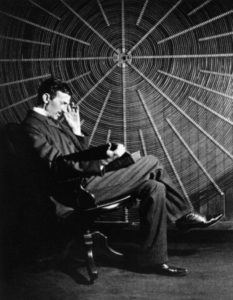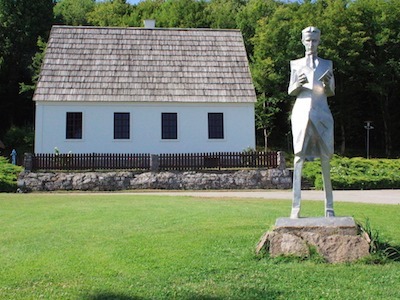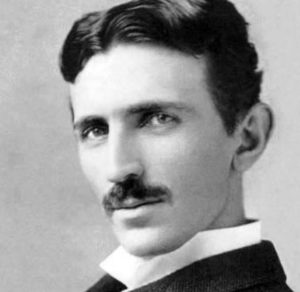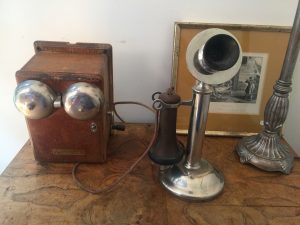Nikola Tesla (10 Jul 1856 – 7 Jan 1943)
BIOGRAPHIES, 29 Jul 2019
Biography and Michel Chossudovsky – TRANSCEND Media Service
Inventor Nikola Tesla contributed to the development of the alternating-current electrical system that’s widely used today and discovered the rotating magnetic field (the basis of most AC machinery).
Nikola Tesla was an engineer known for designing the alternating-current (AC) electric system, which is still the predominant electrical system used across the world today. He also created the “Tesla coil,” which is still used in radio technology.
Born in modern-day Croatia, Tesla came to the United States in 1884 and briefly worked with Thomas Edison before the two parted ways. He sold several patent rights, including those to his AC machinery, to George Westinghouse.
Inventions
Throughout his career, Tesla discovered, designed and developed ideas for a number of important inventions — most of which were officially patented by other inventors — including dynamos (electrical generators similar to batteries) and the induction motor.
He was also a pioneer in the discovery of radar technology, X-ray technology, remote control and the rotating magnetic field — the basis of most AC machinery. Tesla is most well-known for his contributions in AC electricity and for the Tesla coil.
AC Electrical System
Tesla designed the alternating-current (AC) electrical system, which would quickly become the preeminent power system of the 20th century and has remained the worldwide standard ever since. In 1887, Tesla found funding for his new Tesla Electric Company, and by the end of the year he had successfully filed several patents for AC-based inventions.
Tesla’s AC system soon caught the attention of American engineer and businessman George Westinghouse, who was seeking a solution to supplying the nation with long-distance power. Convinced that Tesla’s inventions would help him achieve this, in 1888 he purchased his patents for $60,000 in cash and stock in the Westinghouse Corporation.
Read Article: ‘The Feats and Foibles of Nikola Tesla’
As interest in an AC system grew, Tesla and Westinghouse were put in direct competition with Thomas Edison, who was intent on selling his direct-current (DC) system to the nation. A negative press campaign was soon waged by Edison, in an attempt to undermine interest in AC power.
Unfortunately for Edison, the Westinghouse Corporation was chosen to supply the lighting at the 1893 World’s Columbian Exposition in Chicago, and Tesla conducted demonstrations of his AC system there.
Hydroelectric Power Plant
In 1895, Tesla designed what was among the first AC hydroelectric power plants in the United States, at Niagara Falls.
The following year, it was used to power the city of Buffalo, New York — a feat that was highly publicized throughout the world and helped further AC electricity’s path to becoming the world’s power system.
Tesla Coil
In the late 19th century, Tesla patented the Tesla coil, which laid the foundation for wireless technologies and is still used in radio technology today. The heart of an electrical circuit, the Tesla coil is an inductor used in many early radio transmission antennas.
The coil works with a capacitor to resonate current and voltage from a power source across the circuit. Tesla himself used his coil to study fluorescence, x-rays, radio, wireless power and electromagnetism in the earth and its atmosphere. 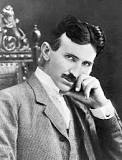
Tesla Motors & the Electric Car
In 2003, a group of engineers founded Tesla Motors, a car company named after Nikola Tesla dedicated to building the first fully electric-powered car. Entrepreneur and engineer Elon Musk contributed over $30 million to Tesla in 2004 and serves as the company’s co-founder CEO.
In 2008, Tesla unveiled its first electric car, the Roadster. A high-performance sports vehicle, the Roadster helped changed the perception of what electric cars could be. In 2014, Tesla launched the Model S, a lower-priced model that, in 2017, set the Motor Trend world record for 0 to 60 miles per hour acceleration at 2.28 seconds.
Tesla’s designs showed that an electric car could have the same performance as gasoline-powered sports car brands like Porsche and Lamborghini.
Where Was Nikola Tesla Born?
Nikola Tesla was born in Smiljan, Croatia, on July 10, 1856.
Childhood and Education
Nikola Tesla was one of five children, including siblings Dane, Angelina, Milka and Marica. Tesla’s interest in electrical invention was spurred by his mother, Djuka Mandic, who invented small household appliances in her spare time while her son was growing up.
Tesla’s father, Milutin Tesla, was a Serbian orthodox priest and a writer, and he pushed for his son to join the priesthood. But Nikola’s interests lay squarely in the sciences.
After studying at the Realschule, Karlstadt (later renamed the Johann-Rudolph-Glauber Realschule Karlstadt); the Polytechnic Institute in Graz, Austria; and the University of Prague during the 1870s, Tesla moved to Budapest, where for a time he worked at the Central Telephone Exchange.
It was while in Budapest that the idea for the induction motor first came to Tesla, but after several years of trying to gain interest in his invention, at age 28 Tesla decided to leave Europe for America.
Nikola Tesla vs. Thomas Edison
In 1884 Tesla arrived in the United States with little more than the clothes on his back and a letter of introduction to famed inventor and business mogul Thomas Edison, whose DC-based electrical works were fast becoming the standard in the country.
Edison hired Tesla, and the two men were soon working tirelessly alongside each other, making improvements to Edison’s inventions.
Several months later, the two parted ways due to a conflicting business-scientific relationship, attributed by historians to their incredibly different personalities: While Edison was a power figure who focused on marketing and financial success, Tesla was commercially out-of-tune and somewhat vulnerable.
First Solo Venture
In 1885, Tesla received funding for the Tesla Electric Light Company and was tasked by his investors to develop improved arc lighting. After successfully doing so, however, Tesla was forced out of the venture and for a time had to work as a manual laborer in order to survive.
His luck would change two years later, when he received funding for his new Tesla Electric Company.
Free Energy
Having become obsessed with the wireless transmission of energy, around 1900 Nikola set to work on his boldest project yet: to build a global, wireless communication system — to be transmitted through a large electrical tower — for sharing information and providing free energy throughout the world.
With funding from a group of investors that included financial giant J. P. Morgan, in 1901 Tesla began work on the free energy project in earnest, designing and building a lab with a power plant and a massive transmission tower on a site on Long Island, New York, that became known as Wardenclyffe.
However, doubts arose among his investors about the plausibility of Tesla’s system. As his rival, Guglielmo Marconi — with the financial support of Andrew Carnegie and Thomas Edison — continued to make great advances with his own radio technologies, Tesla had no choice but to abandon the project.
The Wardenclyffe staff was laid off in 1906, and by 1915 the site had fallen into foreclosure. Two years later Tesla declared bankruptcy and the tower was dismantled and sold for scrap to help pay the debts he had accrued.
Death Ray
After suffering a nervous breakdown following the closure of his free energy project, Tesla eventually returned to work, primarily as a consultant.
But as time went on, his ideas became progressively more outlandish and impractical. He grew increasingly eccentric, devoting much of his time to the care of wild pigeons in the parks of New York City.
Tesla even drew the attention of the FBI with his talk of building a powerful “death ray,” which had received some interest from the Soviet Union during World War II.
How Did Nikola Tesla Die?
Poor and reclusive, Nikola Tesla died of a coronary thrombosis on January 7, 1943, at the age of 86, in New York City, where he had lived for nearly 60 years.
However the legacy of the work Tesla left behind him lives on to this day. In 1994, a street sign identifying “Nikola Tesla Corner” was installed near the site of his former New York City laboratory, at the intersection of 40th Street and 6th Avenue.
Movies on Tesla
Several movies have highlighted Tesla’s life and famous works, most notably:
- The Secret of Nikola Tesla, a 1980 biographical film starring Orson Welles as J. P. Morgan.
- Nikola Tesla, The Genius Who Lit the World, a 1994 documentary produced by the Tesla Memorial Society and the Nikola Tesla Museum in Belgrade, Serbia.
- The Prestige, a 2006 fictional film about two magicians directed by Christopher Nolan, with rock star David Bowie portraying Tesla.
Tesla Science Center and Wardenclyffe
Since Tesla’s original forfeiture of his free energy project, ownership of the Wardenclyffe property has passed through numerous hands. Several attempts have been made to preserve it, but in 1967, 1976 and 1994 efforts to have it declared a national historic site failed.
Then, in 2008, a group called the Tesla Science Center (TSC) was formed with the intention of purchasing the property and turning it into a museum dedicated to the inventor’s work.
In 2009, the Wardenclyffe site went on the market for nearly $1.6 million, and for the next several years, the TSC worked diligently to raise funds for its purchase. In 2012, public interest in the project peaked when Matthew Inman of TheOatmeal.com collaborated with the TSC in an Internet fundraising effort, ultimately receiving enough contributions to acquire the site in May 2013.
Work on its restoration is still in progress, and the site is closed to the public “for the foreseeable future” for reasons of safety and preservation, according to the Tesla Science Center.
Go to Original – biography.com
*****************************************************************
Who Was Nikolas Tesla?
By Nikola Tesla and Prof Michel Chossudovsky – Global Research
Very few people know who Nikola Tesla is. They have heard of the Tesla electric car, but generally the broader public is unfamiliar with Nikola Tesla, the Serbian scientist and his path breaking inventions in electricity and wireless technology. Many of his inventions were stolen by US corporations. Wireless technology was in large part based on Tesla inventions.
Nikola Tesla foresaw the advent of the cell phone back in 1926:
“We shall be able to communicate with one another instantly, irrespective of distance. … and the instruments through which we shall be able to do this will be amazingly simple compared with our present telephone. A man will be able to carry one in his vest pocket.”
In a January 30, 1926 interview in Collier’s, Tesla revealed with tremendous foresight what a Future World with wireless technology would look like. In other words, he described the World in which we live in today. “When wireless technology is perfectly applied, the whole earth will be converted into a huge brain.” Does this not describe our World today?
In fact Tesla described a World Beyond today’s World:
“Belted parking towers will arise in our large cities, and the roads will be multiplied through sheer necessity, or finally rendered unnecessary when civilization exchanges wheels for wings.
Tesla’s perspective was largely humanitarian reflecting a historical commitment to social progress. It was unduly optimistic. The military applications of wireless technology which constitute the basis of modern warfare were not mentioned. Neither did he focus on the potential impacts of wireless radiation on human health (Beware of 5G: a Health Hazard for Future Generations and the Public is Not Informed).
— Michel Chossudovsky
***
Below are excerpts from Tesla’s historic 1926 interview (emphasis added):
From the inception of the wireless system,… I saw that this new art of applied electricity would be of greater benefit to the human race than any other scientific discovery, for it virtually eliminates distance.
The majority of the ills from which humanity suffers are due to the immense extent of the terrestrial globe and the inability of individuals and nations to come into close contact.
Wireless will achieve the closer contact through transmission of intelligence, transport of our bodies and materials and conveyance of energy.
When wireless is perfectly applied the whole earth will be converted into a huge brain, which in fact it is, all things being particles of a real and rhythmic whole. We shall be able to communicate with one another instantly, irrespective of distance.
 Not only this, but through television and telephony we shall see and hear one another as perfectly as though we were face to face, despite intervening distances of thousands of miles; and the instruments through which we shall be able to do his will be amazingly simple compared with our present telephone.
Not only this, but through television and telephony we shall see and hear one another as perfectly as though we were face to face, despite intervening distances of thousands of miles; and the instruments through which we shall be able to do his will be amazingly simple compared with our present telephone.
A man will be able to carry one in his vest pocket. [i.e. a mobile cell phone]
We shall be able to witness and hear events–the inauguration of a President, the playing of a world series game, the havoc of an earthquake or the terror of a battle–just as though we were present.
When the wireless transmission of power is made commercial, transport and transmission will be revolutionized. Already motion pictures have been transmitted by wireless over a short distance.
Later the distance will be illimitable, and by later I mean only a few years hence. Pictures are transmitted over wires–they were telegraphed successfully through the point system thirty years ago. When wireless transmission of power becomes general, these methods will be as crude as is the steam locomotive compared with the electric train.
Perhaps the most valuable application of wireless energy will be the propulsion of flying machines, which will carry no fuel and will be free from any limitations of the present airplanes and dirigibles. We shall ride from New York to Europe in a few hours. International boundaries will be largely obliterated and a great step will be made toward the unification and harmonious existence of the various races inhabiting the globe. Wireless will not only make possible the supply of energy to region, however inaccessible, but it will be effective politically by harmonizing international interests; it will create understanding instead of differences.
Modern systems of power transmission will become antiquated. Compact relay stations one half or one quarter the size of our modern power plants will be the basis of operation–in the air and under the sea, for water will effect small loss in conveying energy by wireless.”
Present wireless receiving apparatus … will be scrapped for much simpler machines; static and all forms of interference will be eliminated, so that innumerable transmitters and receivers may be operated without interference. It is more than probable that the household’s daily newspaper will be printed ‘wirelessly’ in the home during the night. Domestic management–the problems of heat, light and household mechanics–will be freed from all labor through beneficent wireless power.
I foresee the development of the flying machine exceeding that of the automobile, and I expect Mr. Ford to make large contributions toward this progress. The problem of parking automobiles and furnishing separate roads for commercial and pleasure traffic will be solved. Belted parking towers will arise in our large cities, and the roads will be multiplied through sheer necessity, or finally rendered unnecessary when civilization exchanges wheels for wings.
The world’s internal reservoirs of heat, indicated by frequent volcanic eruptions, will be tapped for industrial purposes. In an article I wrote twenty years ago I defined a process for continuously converting to human use part of the heat received from the sun by the atmosphere. Experts have jumped to the conclusion that I am attempting to realize a perpetual-motion scheme. But my process has been carefully worked out. It is rational.”
(quoted from John B. Kennedy, An Interview with Nikola Tesla, Collier Magazine, January 30, 1922)
httpv://www.youtube.com/watch?v=h5uiK_QnyrE
___________________________________________________
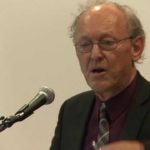 Michel Chossudovsky is an award-winning author, Professor of Economics (emeritus) at the University of Ottawa, Founder and Director of the Centre for Research on Globalization (CRG), Montreal and Editor of the globalresearch.ca website. He is the author of The Globalization of Poverty and The New World Order (2003) and America’s “War on Terrorism”(2005). His most recent book is entitled Towards a World War III Scenario: The Dangers of Nuclear War (2011).
Michel Chossudovsky is an award-winning author, Professor of Economics (emeritus) at the University of Ottawa, Founder and Director of the Centre for Research on Globalization (CRG), Montreal and Editor of the globalresearch.ca website. He is the author of The Globalization of Poverty and The New World Order (2003) and America’s “War on Terrorism”(2005). His most recent book is entitled Towards a World War III Scenario: The Dangers of Nuclear War (2011).
Go to Original – globalresearch.ca
Tags: Biography
DISCLAIMER: The statements, views and opinions expressed in pieces republished here are solely those of the authors and do not necessarily represent those of TMS. In accordance with title 17 U.S.C. section 107, this material is distributed without profit to those who have expressed a prior interest in receiving the included information for research and educational purposes. TMS has no affiliation whatsoever with the originator of this article nor is TMS endorsed or sponsored by the originator. “GO TO ORIGINAL” links are provided as a convenience to our readers and allow for verification of authenticity. However, as originating pages are often updated by their originating host sites, the versions posted may not match the versions our readers view when clicking the “GO TO ORIGINAL” links. This site contains copyrighted material the use of which has not always been specifically authorized by the copyright owner. We are making such material available in our efforts to advance understanding of environmental, political, human rights, economic, democracy, scientific, and social justice issues, etc. We believe this constitutes a ‘fair use’ of any such copyrighted material as provided for in section 107 of the US Copyright Law. In accordance with Title 17 U.S.C. Section 107, the material on this site is distributed without profit to those who have expressed a prior interest in receiving the included information for research and educational purposes. For more information go to: http://www.law.cornell.edu/uscode/17/107.shtml. If you wish to use copyrighted material from this site for purposes of your own that go beyond ‘fair use’, you must obtain permission from the copyright owner.
